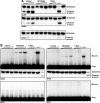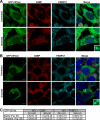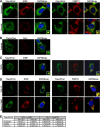Regulation of Human Endonuclease V Activity and Relocalization to Cytoplasmic Stress Granules
- PMID: 27573237
- PMCID: PMC5076846
- DOI: 10.1074/jbc.M116.730911
Regulation of Human Endonuclease V Activity and Relocalization to Cytoplasmic Stress Granules
Abstract
Endonuclease V (EndoV) is an enzyme with specificity for inosines in nucleic acids. Whereas the bacterial homologs are active on both DNA and RNA, the mammalian variants only cleave RNA, at least when assayed with recombinant proteins. Here we show that ectopically expressed, as well as endogenously expressed human (h)EndoV, share the same enzymatic properties as the recombinant protein and cleaves RNA with inosine but not DNA. In search for proteins interacting with hEndoV, polyadenylate-binding protein C1 (PABPC1) was identified. The association between PABPC1 and hEndoV is RNA dependent and furthermore, PABPC1 stimulates hEndoV activity and affinity for inosine-containing RNA. Upon cellular stress, PABPC1 relocates to cytoplasmic stress granules that are multimolecular aggregates of stalled translation initiation complexes formed to aid cell recovery. Arsenite, as well as other agents, triggered relocalization also of hEndoV to cytoplasmic stress granules. As inosines in RNA are highly abundant, hEndoV activity is likely regulated in cells to avoid aberrant cleavage of inosine-containing transcripts. Indeed, we find that hEndoV cleavage is inhibited by normal intracellular ATP concentrations. The ATP stores inside a cell do not overlay stress granules and we suggest that hEndoV is redistributed to stress granules as a strategy to create a local environment low in ATP to permit hEndoV activity.
Keywords: ATP; PABPC1; RNA; RNA processing; deamination; endonuclease V; inosine; nitrosative stress; ribonuclease; stress granule.
© 2016 by The American Society for Biochemistry and Molecular Biology, Inc.
Figures









Similar articles
-
Complex alternative splicing of human Endonuclease V mRNA, but evidence for only a single protein isoform.PLoS One. 2019 Nov 8;14(11):e0225081. doi: 10.1371/journal.pone.0225081. eCollection 2019. PLoS One. 2019. PMID: 31703097 Free PMC article.
-
Crystal structure and MD simulation of mouse EndoV reveal wedge motif plasticity in this inosine-specific endonuclease.Sci Rep. 2016 Apr 25;6:24979. doi: 10.1038/srep24979. Sci Rep. 2016. PMID: 27108838 Free PMC article.
-
Structure of human endonuclease V as an inosine-specific ribonuclease.Acta Crystallogr D Biol Crystallogr. 2014 Sep;70(Pt 9):2286-94. doi: 10.1107/S139900471401356X. Epub 2014 Aug 29. Acta Crystallogr D Biol Crystallogr. 2014. PMID: 25195743
-
Structural basis for incision at deaminated adenines in DNA and RNA by endonuclease V.Prog Biophys Mol Biol. 2015 Mar;117(2-3):134-142. doi: 10.1016/j.pbiomolbio.2015.03.005. Epub 2015 Mar 28. Prog Biophys Mol Biol. 2015. PMID: 25824682 Review.
-
Diversity of Endonuclease V: From DNA Repair to RNA Editing.Biomolecules. 2015 Sep 24;5(4):2194-206. doi: 10.3390/biom5042194. Biomolecules. 2015. PMID: 26404388 Free PMC article. Review.
Cited by
-
Complex alternative splicing of human Endonuclease V mRNA, but evidence for only a single protein isoform.PLoS One. 2019 Nov 8;14(11):e0225081. doi: 10.1371/journal.pone.0225081. eCollection 2019. PLoS One. 2019. PMID: 31703097 Free PMC article.
-
Endonuclease V Regulates Atherosclerosis Through C-C Motif Chemokine Ligand 2-Mediated Monocyte Infiltration.J Am Heart Assoc. 2021 Jul 20;10(14):e020656. doi: 10.1161/JAHA.120.020656. Epub 2021 Jul 14. J Am Heart Assoc. 2021. PMID: 34259011 Free PMC article.
-
Deletion of Endonuclease V suppresses chemically induced hepatocellular carcinoma.Nucleic Acids Res. 2020 May 7;48(8):4463-4479. doi: 10.1093/nar/gkaa115. Nucleic Acids Res. 2020. PMID: 32083667 Free PMC article.
-
Altered Levels of Proteins and Phosphoproteins, in the Absence of Early Causative Transcriptional Changes, Shape the Molecular Pathogenesis in the Brain of Young Presymptomatic Ki91 SCA3/MJD Mouse.Mol Neurobiol. 2019 Dec;56(12):8168-8202. doi: 10.1007/s12035-019-01643-4. Epub 2019 Jun 14. Mol Neurobiol. 2019. PMID: 31201651 Free PMC article.
-
Functional and molecular dissection of HCMV long non-coding RNAs.Sci Rep. 2022 Nov 11;12(1):19303. doi: 10.1038/s41598-022-23317-3. Sci Rep. 2022. PMID: 36369338 Free PMC article.
References
-
- Lindahl T. (1993) Instability and decay of the primary structure of DNA. Nature 362, 709–715 - PubMed
-
- Pang B., McFaline J. L., Burgis N. E., Dong M., Taghizadeh K., Sullivan M. R., Elmquist C. E., Cunningham R. P., and Dedon P. C. (2012) Defects in purine nucleotide metabolism lead to substantial incorporation of xanthine and hypoxanthine into DNA and RNA. Proc. Natl. Acad. Sci. U.S.A. 109, 2319–2324 - PMC - PubMed
-
- Yasui M., Suenaga E., Koyama N., Masutani C., Hanaoka F., Gruz P.,Shibutani S., Nohmi T., Hayashi M., and Honma M. (2008) Miscoding properties of 2′-deoxyinosine, a nitric oxide-derived DNA adduct, during translesion synthesis catalyzed by human DNA polymerases. J. Mol. Biol. 377, 1015–1023 - PubMed
-
- Alseth I., Dalhus B., and Bjørås M. (2014) Inosine in DNA and RNA. Curr. Opin. Genet. Dev. 26, 116–123 - PubMed
MeSH terms
Substances
LinkOut - more resources
Full Text Sources
Other Literature Sources
Molecular Biology Databases
Research Materials

